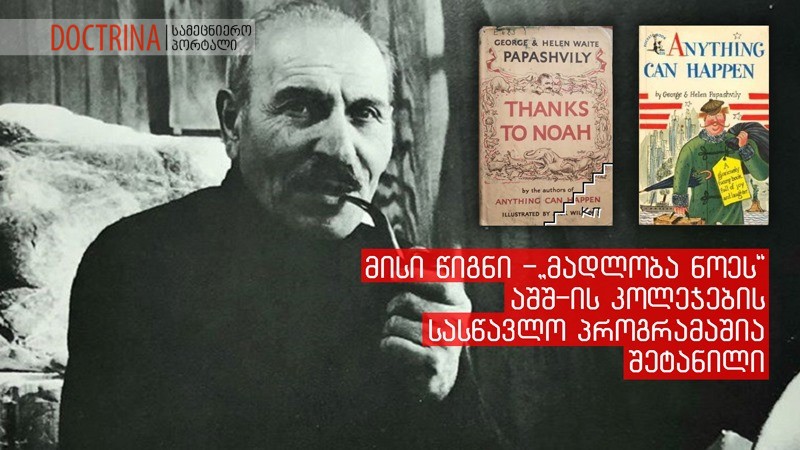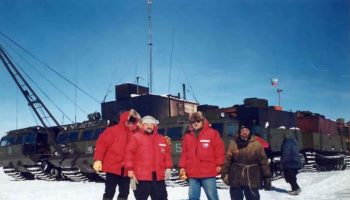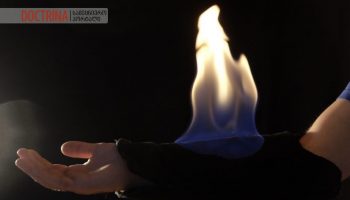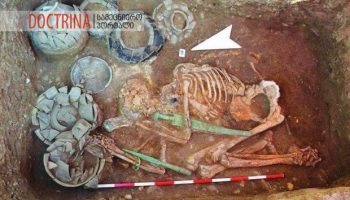In 1921, before the Soviet regime was established, a 19-20 year old soldier sailed from the port of Batumi to Constantinople. Unexplained ways of life brought him from Constantinople to America, a dreamland where his life has turned into a great tale.
The soldier was named George (Giorgi) Papashvili, and later his English-language book, Anything Can Happen, about Georgia and emigration, became a bestseller in America in the 40’s and 1, 5 million copies of the book were sold worldwide. The book has been translated into 15 languages and in 1950, George Papashvili was included in the list of America’s 50 Favorite Literatures along with Jack London, Eugene O’Neill, Faulkner, Hemingway and other writers. Under the same title, a film, directed by well-known Director George Seaton, was made at Hollywood in 1952. The film was awarded the “Gold Globe” at a film festival in Los Angeles, California, in the nomination “Best Film Promoting International Understanding”.
The book tells about Papashvili’s native village Kobiantkari, his relatives, emigration, the reality of self-assertion by immigrants in America – and he tells about it lightly and amusingly.
George Papashvili has been little- known in Georgia so far. His writings have not even been considered immigrant literature, all American editions mention him as an “American writer and sculptor of Georgian origin.”
Anything Can Happen was translated into Georgian in the 60s by Andukafar Cheishvili, but the book was not available to everyone due to a small run of the book.
“Unknown George (Giorgi) Papashvili” – by Rusudan Nishnianidze, Iv. Javakhishvili Tbilisi State University Professor, is the first two-volume work about Papashvili. The author has published it after she thoroughly studied a special collection of George and Helen White Papashvilis at Lehigh University in in Pennsylvania, the US, where this unique archive is preserved.
Rusudan Nishnianidze tells us about George Papashvili’s works:
Anything Can Happen
The author recalls Georgia, its habits, he writes about everything – whatever he likes and dislikes in America. Here you will find stories of how emigrants behave and how Giorgi himself behaves in the US. George is the main protagonist who lives with Russian emigrants.
In Munich, I saw this book translated into Russian. In the Soviet era, the translator removed 9 out of 20 chapters, describing the life of Russian emigrants in America.
It was a “masterful” measure of the Soviet security services – the book was translated, but in a way that no one liked, and no interest appeared in the author.
The film was awarded the Golden Globe for the nomination : a Film Promoting the International Consent. The film was directed by the famous George Seaton, whose films have been nominated numerous times for the American Film Academy Award.
“George Papashvili has left us something more than anything else – he has shared the true meaning of friendship, compassion, unity, and love,” film’s director Gorge Seaton said while speaking at George Papashvili’s funeral.
George Papashvili – sculptor
George Papashvili was a great gsculptor. His works were exhibited at the Pennsylvania Academy of Fine Arts, the University of Philadelphia, and etc.
Arthur Stenius, who owned a large documentary corporation in the US, made a documentary on Papashvili called “Beauty in the Stone.”
Their estate, located in the state of Pennsylvania, consisted of hunting grounds, forests, and springs. Behind it there were Granite Mountains, from where the sculptor brought material and made sculptures in his workshop.
Stenius’ documentary about George Papashvili is kept at the University of Wayne in Detroit.
George and Helen White Papashvilis are the authors of the works : “Yeah and No”, “Home, and Home Again “, “Russian (World) Culinary”, “Thank to Noah” and “Dogs and Humans.”
I worked at the Paris-Lavelle and Harvard archives several years ago and it was a great professional experience for me. In various archives, George Papashvili’s name was repeatedly mentioned in an interesting context and it means that he was a very successful Georgian man. I started collecting information about him, contacted various archives in America, I received a letter from Pennsylvania, saying they would open a special collection of Papashvilis if I arrived on the ground for the research. In the same year, in 2012, I did not miss my chance and left for the US on a scientific trip. My two-volume book- “Georgia before Saman … and beyond Saman…” – was exhibited at the demonstration hall of Congress. These books were mainly a study of the texts written by the Georgian migrants in Europe.
Georgian authors in Europe wrote mostly for Georgian readers. While Papashvili’s texts were written in English. Nobody knew young Papashvili who left Georgia. In his memories Giorgi Papashvili writes that when he arrived in America he used a sign language “to talk to America”, since he did not know English.
The book “Anything Can Happen” was first published in the United States in 1944, before it, the book had been published in separate chapters in The Commune Ground, then the book was published three times : in October, November and December. In 1945, “Anything Can Happen” was recognized as a bestseller. I have seen over 600 reviews and literary letters in the archive, which I think is a very serious feedback. The translations of main and significant part of those reviews and letters are presented in my book. It was another proof that Georgia has lost a great man. Many talented Georgians were forced to leave the country in those years.
George’s wife, Helen, was a very educated woman. She studied at the University of Berkeley and was the author of several books. She recorded the Georgian-American stories told by George. The Soviet press wrote that Anything can happen was not Papashvili’s story and as if Helen wrote the book, but it is impossible for an American woman to know about Kobiantkari, Khevsureti, Georgian people in general, Khinkali and etc. Anything can happen, but not so much!
Thank to Noah is the book about pets for kids. The book was translated into Georgian by Mr. Andukafar Cheishvili.
I wanted some chapters of this text to be included in Georgian textbooks. I was pleasantly surprised when I saw in the archive the book was compulsory in 250 American high schools. It seems the American education system and I had the same opinion over this issue.
Home, and Home Again is the latest book by George Papashvily and Helen. 73,000 copies of the book were printed, though it failed to become a bestseller like the first book.
Papashvili arrived in Georgia in 1961 and was offered to stay with his wife here, but he refused: “I can’t stay, my ‘home’, my job, my life is already in the United States”, he said.
George Papashvili, who has been little-known in Georgia so far, died in 1978 at the age of 80 and is buried in Pennsylvania.
The Hall of Young Scientists & Analysts – “Doctrina”







